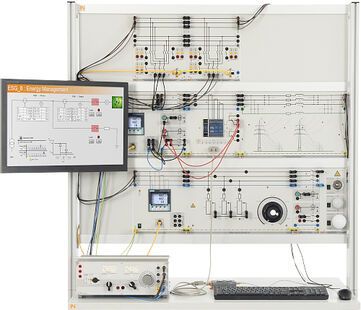EIS Introduction to Smart Grid
EIS Introduction to Smart Grid

The equipment set is designed to provide a simple introduction to the Smart Grid.
Power generation
Electrical current is primarily produced by three-phase generators. This is true for power plants as well as for emergency generators and wind-powered generators. For the experiments, a controllable three-phase power system is used to emulate three-phase generators.
Power transmission
The transmission line model is designed such that the model voltages are between 110 V and 380 V. Various cable lengths can be selected using corresponding overlay masks. The investigations conducted on the training system can be performed in no-load, in standard operation, in short-circuit mode and with unbalanced faults. For the sake of safety, the investigations on 380 kV and 110 kV transmission lines and their interconnection are all done on the low voltage level without losing the properties of real high-voltage transmission lines. The realistic line models of a 380 kV transmission line and a 110 kV cable model are automatically switched between the cable line lengths of 95 miles and 190 miles (150 km and 300 km) when the overlay mask is installed.
Protective circuitry
A component failure in power supply systems in low, medium and high voltage grids can have huge repercussions on any power systems downstream and on the power grid itself. Let’s also not forget that these components are also valuable assets. The protective circuitry is supposed to protect the components from the repercussions of electrical faults and ensure a reliable power supply to consumers not affected by these failures. In this process, faults have to be detected rapidly and definitively and must be selectively disabled.
Power distribution
In larger switchgear systems, the distribution of electrical power is done almost exclusively via double busbar systems. These systems contain coupling fields for the connection of the two busbars, the incoming and outgoing feeder as well as the measuring fields. Circuit breakers are used in the incoming-feeder, outgoing-feeder and coupling fields and there is an isolating switch for each busbar connection. Here the switching logic has to be strictly complied with for safety reasons. The double busbar model contains all of the functions which are relevant on the job. Built-in measuring instruments for currents and voltages permit immediate analysis of switching operations.
Investigating loads
Experiments on reducing load spikes through measurements with active current and industry smart meters demonstrate how the load of a power supply grid can be reduced and distributed evenly over a period of 24 hours. That way each experiment makes it possible to do a detailed investigation of steady-state, balanced and unbalanced loads.
Energy management
For commercial and ecological reasons, a rational utilisation of energy is becoming ever more important. That way each experiment makes it possible to do a detailed investigation of steady-state, balanced and unbalanced loads. All of the experiments use SCADA software (Supervisory Control and Data Acquisition) for the monitoring and controlling operations.
Training content:
Three-phase power generation
- Controllable three-phase power supply
- Output voltage 3x 0...450 V, 50/60 Hz adjustable
- Three-phase transformer
Three-phase power transmission line
- Cable parameters
- Line operation in no-load mode
- Line operation with matching
- Line operation for balanced (symmetrical) short-circuit
- Line operation with a resistive load
- Power transmission losses, efficiency
- Reactive power compensation
- Automatic voltage control
Three-phase time overcurrent relay
- Ratings and parametrization of time overcurrent protection
- Theoretical fundamentals of protective circuitry and of time overcurrent protection
- Determining the return transfer ratios for one, two-pole and three-pole short-circuit
- Testing the tripping characteristic of a power circuit-breaker in the event of a fault
Three-phase power distribution
- Understand the basic design of switchgear systems
- Understand the difference between an isolating switch and a power circuit-breaker
- Become familiar with the functions of double busbars
- Analyse the power distribution in switchgear systems
- Practice the right switching sequences
- Safe switching of outgoing feeders
- Switching busbars
- Develop technical skills and know-how (improper switching can be very expensive)
Three-phase power loads
- Three-phase loads in star and delta circuit configuration
- Measurements with active (watt) power and reactive (Var) power meters
- Steady-state, balanced and unbalanced loads
Three-phase energy management
- Load management using PLC software
- Demand Side Management
- Recording load profiles with SCADA